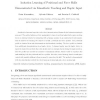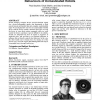267 search results - page 46 / 54 » Introduction to human-robot interaction |
HRI
2007
ACM
14 years 1 months ago
2007
ACM
Good situation awareness (SA) is especially necessary when robots and their operators are not collocated, such as in urban search and rescue (USAR). This paper compares how SA is ...
HRI
2007
ACM
14 years 1 months ago
2007
ACM
It is often desirable for a human to manage multiple robots. Autonomy is required to keep workload within tolerable ranges, and dynamically adapting the type of autonomy may be us...
AR
2011
13 years 4 months ago
2011
A method to learn and reproduce robot force interactions in a Human-Robot Interaction setting is proposed. The method allows a robotic manipulator to learn to perform tasks which ...
HRI
2009
ACM
14 years 4 months ago
2009
ACM
Several emerging computer devices read bio-electrical signals (e.g., electro-corticographic signals, skin biopotential or facial muscle tension) and translate them into computer- ...
HRI
2009
ACM
14 years 4 months ago
2009
ACM
During conversations, speakers establish their and others’ participant roles (who participates in the conversation and in what capacity)—or “footing” as termed by Goffman�...


